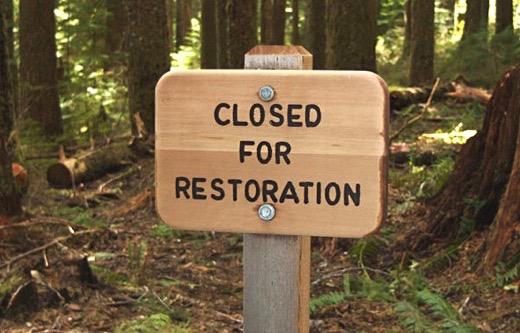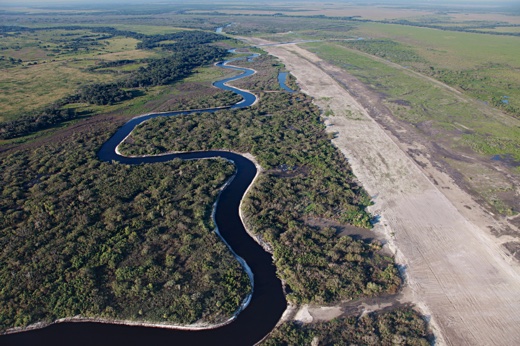SUBHEAD: Restoring degraded ecosystems using renaturalization and reforestation to achieve resilience.
By Andrew Urevig on 12 april 21017 for Ensia -
(https://ensia.com/notable/habitat-restoration-climate-change/)

Image above: "Closed for Restoration" sign in forest. From original article.
[IB Publisher's note: Water diversion for agriculture has been a historic problem for Hawaii. It is not that man made efforts to modify nature are bad in themselves, but whether they make nature more fragile or more resilient. Supporting life's diversity by slowing the movement and spreading the reach of water is one thing; but using water to advance profits and increase human impact on the land through development is another.]
Florida’s Kissimmee River once flowed freely. Fish, birds and other wildlife dwelled in the wetlands it fed. But in the 1960s, spurred by public outrage over flooding, the U.S. Army Corps of Engineers straightened the winding waterway and turned it into a drainage canal.
Flip forward a few decades and the river is returning — at least in part. The U.S. Army Corps of Engineers has partnered with the South Florida Water Management District on the Kissimmee River Restoration Project, aiming to restore a long section of the river to its natural state.
How can the Kissimmee team and others best restore degraded environments in the face of the unpredictable and tumultuous future that climate change promises?
A big part of the answer is by building in resilience — the ability to resist change or to recover from disturbance in a way that preserves the essence of a system’s structure and function.
To that end, Britta Timpane-Padgham, a fisheries biologist at the National Oceanic and Atmospheric Administration’s Northwest Fisheries Science Center, and colleagues have created an interactive decision support table that restoration professionals can use to choose strategies and goals that best boost climate change resilience in the systems in which they’re working.
Published last month in the scientific journal PLOS ONE, the table is based on a review of hundreds of studies of restoration projects covering a number of ecosystem types, including rivers, coasts, forests and lakes.
Timpane-Padgham and colleagues reviewed the studies and identified 45 factors — ranging from genetic diversity to habitat connectivity to air carbon balance — that build resilience into restoration projects.

Image above: Through Kissemmee River Restoration water was routed back into a natural channel from straight drainage ditch it had been forced into improving Florida's ecosystem. From (https://www.tes.com/lessons/IO8d-fSGuKa1uA/ib-freshwater-part-3-river-floodplains-at-rhsb).
A few major themes popped up again and again. Connections between different areas let species move and migrate, which is crucial to resilience in many restoration efforts, including Florida’s Kissimmee River project. Habitat variability helps by making ecosystems more resilient to extreme climate events. A history of natural disturbance also can contribute to successful restoration.
The decision support table sorts resilience attributes into five categories based roughly on ecological scale: individual, population, community, ecosystem and process. Life span and reproductive strategy, for example, are individual attributes, while population density and genetic diversity are population attributes.
Ecosystem attributes include habitat area, habitat condition and connections between different habitats.
Each of the 45 attributes has two components: the project’s focus (whether it aims to restore a species, a habitat, or a whole system) and the project’s scale (whether it’s operating on one population, a single site, or an entire ecosystem).
Anyone who is interested can download and use the decision support table, which comes as an Excel spreadsheet (click the “S1 Table” link on the paper’s PLOS ONE page).
For guidance on a project, practitioners simply choose an appropriate focus and scale, then the table returns a list of attributes in the five categories that can best help build resilience under that project’s unique circumstances. Users are encouraged to provide feedback to the project team so the tool can be improved in the future.
“In the face of climate change,” the study notes, “restoration approaches that promote natural sources of resilience are more likely to be successful than those that focus on creating optimal steady states.”.
By Andrew Urevig on 12 april 21017 for Ensia -
(https://ensia.com/notable/habitat-restoration-climate-change/)

Image above: "Closed for Restoration" sign in forest. From original article.
[IB Publisher's note: Water diversion for agriculture has been a historic problem for Hawaii. It is not that man made efforts to modify nature are bad in themselves, but whether they make nature more fragile or more resilient. Supporting life's diversity by slowing the movement and spreading the reach of water is one thing; but using water to advance profits and increase human impact on the land through development is another.]
Florida’s Kissimmee River once flowed freely. Fish, birds and other wildlife dwelled in the wetlands it fed. But in the 1960s, spurred by public outrage over flooding, the U.S. Army Corps of Engineers straightened the winding waterway and turned it into a drainage canal.
Flip forward a few decades and the river is returning — at least in part. The U.S. Army Corps of Engineers has partnered with the South Florida Water Management District on the Kissimmee River Restoration Project, aiming to restore a long section of the river to its natural state.
How can the Kissimmee team and others best restore degraded environments in the face of the unpredictable and tumultuous future that climate change promises?
A big part of the answer is by building in resilience — the ability to resist change or to recover from disturbance in a way that preserves the essence of a system’s structure and function.
To that end, Britta Timpane-Padgham, a fisheries biologist at the National Oceanic and Atmospheric Administration’s Northwest Fisheries Science Center, and colleagues have created an interactive decision support table that restoration professionals can use to choose strategies and goals that best boost climate change resilience in the systems in which they’re working.
Published last month in the scientific journal PLOS ONE, the table is based on a review of hundreds of studies of restoration projects covering a number of ecosystem types, including rivers, coasts, forests and lakes.
Timpane-Padgham and colleagues reviewed the studies and identified 45 factors — ranging from genetic diversity to habitat connectivity to air carbon balance — that build resilience into restoration projects.

Image above: Through Kissemmee River Restoration water was routed back into a natural channel from straight drainage ditch it had been forced into improving Florida's ecosystem. From (https://www.tes.com/lessons/IO8d-fSGuKa1uA/ib-freshwater-part-3-river-floodplains-at-rhsb).
A few major themes popped up again and again. Connections between different areas let species move and migrate, which is crucial to resilience in many restoration efforts, including Florida’s Kissimmee River project. Habitat variability helps by making ecosystems more resilient to extreme climate events. A history of natural disturbance also can contribute to successful restoration.
The decision support table sorts resilience attributes into five categories based roughly on ecological scale: individual, population, community, ecosystem and process. Life span and reproductive strategy, for example, are individual attributes, while population density and genetic diversity are population attributes.
Ecosystem attributes include habitat area, habitat condition and connections between different habitats.
Each of the 45 attributes has two components: the project’s focus (whether it aims to restore a species, a habitat, or a whole system) and the project’s scale (whether it’s operating on one population, a single site, or an entire ecosystem).
Anyone who is interested can download and use the decision support table, which comes as an Excel spreadsheet (click the “S1 Table” link on the paper’s PLOS ONE page).
For guidance on a project, practitioners simply choose an appropriate focus and scale, then the table returns a list of attributes in the five categories that can best help build resilience under that project’s unique circumstances. Users are encouraged to provide feedback to the project team so the tool can be improved in the future.
“In the face of climate change,” the study notes, “restoration approaches that promote natural sources of resilience are more likely to be successful than those that focus on creating optimal steady states.”.
No comments :
Post a Comment